Giải các hệ phương trình sau:
a.{1/x - 1/y = 1
{2/x - 3/y = 5
b.{15/x - 7/y = 9
{4/x + 9/y = 35
AQ
Những câu hỏi liên quan
Giải hệ phương trình sau:
{15/x - 7/y = 9
{4/x + 9/y = 35
\(\left\{{}\begin{matrix}\dfrac{15}{x}-\dfrac{7}{y}=9\\\dfrac{4}{x}+\dfrac{9}{y}=35\end{matrix}\right.\Leftrightarrow\left\{{}\begin{matrix}\dfrac{60}{x}-\dfrac{28}{y}=36\\\dfrac{60}{x}+\dfrac{135}{y}=525\end{matrix}\right.\)
\(\Leftrightarrow\left\{{}\begin{matrix}\dfrac{-163}{y}=-489\\\dfrac{4}{x}+\dfrac{9}{y}=35\end{matrix}\right.\Leftrightarrow\left\{{}\begin{matrix}y=\dfrac{1}{3}\\x=\dfrac{1}{2}\end{matrix}\right.\)
Đúng 1
Bình luận (0)
Giải các hệ phương trình sau:
a.{ x + 4y = -11
{ 5x - 4y = 1
b.{ 2x - y = 7
{ 3x + 5y + 22 = 0
c.{ 2(x - 2) + 3(1 + y) = 2
{ 3(x - 2) - 2(1 + y) = -3
d.{ (x - 5)(y - 2) = (x + 2)(y - 1)
{ (x - 4)(y + 7) = (x - 3)(y + 4)
e.{ 1/x - 1/y = 1
{ 3/x + 4/y = 5
a: \(\left\{{}\begin{matrix}x+4y=-11\\5x-4y=1\end{matrix}\right.\Leftrightarrow\left\{{}\begin{matrix}6x=-10\\x+4y=-11\end{matrix}\right.\Leftrightarrow\left\{{}\begin{matrix}x=\dfrac{-5}{3}\\y=\dfrac{-11-x}{4}=\dfrac{-11+\dfrac{5}{3}}{4}=-\dfrac{7}{3}\end{matrix}\right.\)
b: \(\left\{{}\begin{matrix}2x-y=7\\3x+5y=-22\end{matrix}\right.\Leftrightarrow\left\{{}\begin{matrix}6x-3y=21\\6x+15y=-66\end{matrix}\right.\)
\(\Leftrightarrow\left\{{}\begin{matrix}-18y=78\\2x-y=7\end{matrix}\right.\Leftrightarrow\left\{{}\begin{matrix}y=\dfrac{-13}{3}\\x=\dfrac{y+7}{2}=\dfrac{4}{3}\end{matrix}\right.\)
Đúng 2
Bình luận (0)
Giải các hệ phương trình sau a) (x - 3)(2y + 5) = (2x + 7)( y- 1) (4x + 1)(3y - 6) = (6x - 1)(2y + 3) b) 15/x - 7/y = 9 4/x + 9/y = 35
Giải các hệ phương trình sau:
a
)
2
(
x
+
y
)
+
3
(
x
−
y...
Đọc tiếp
Giải các hệ phương trình sau:
a ) 2 ( x + y ) + 3 ( x − y ) = 4 ( x + y ) + 2 ( x − y ) = 5 b ) 2 ( x − 2 ) + 3 ( 1 + y ) = − 2 3 ( x − 2 ) − 2 ( 1 + y ) = − 3
Bài toán này có hai cách giải:
Cách 1: Thu gọn từng phương trình ta sẽ thu được phương trình bậc nhất hai ẩn x và y.
Cách 2: Đặt ẩn phụ.
Cách 1:

 (hệ số của y bằng nhau nên ta trừ từng vế hai phương trình)
(hệ số của y bằng nhau nên ta trừ từng vế hai phương trình)
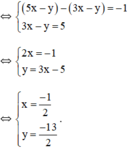
Vậy hệ phương trình có nghiệm duy nhất 
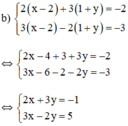
(Nhân hai vế pt 1 với 2; pt 2 với 3 để hệ số của y đối nhau)
 (Hệ số của y đối nhau nên ta cộng từng vế của hai pt)
(Hệ số của y đối nhau nên ta cộng từng vế của hai pt)
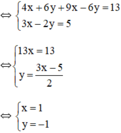
Vậy hệ phương trình có nghiệm duy nhất (1; -1).
Cách 2:
a) Đặt x + y = u và x – y = v (*)
Khi đó hệ phương trình trở thành
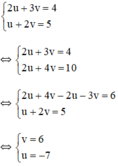
Thay u = -7 và v = 6 vào (*) ta được hệ phương trình:
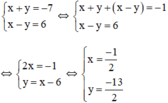
Vậy hệ phương trình có nghiệm 
b) Đặt x – 2 = u và y + 1 = v.
Khi đó hệ phương trình trở thành :
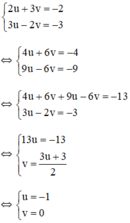
+ u = -1 ⇒ x – 2 = -1 ⇒ x = 1.
+ v = 0 ⇒ y + 1 = 0 ⇒ y = -1.
Vậy hệ phương trình có nghiệm (1; -1).
Đúng 0
Bình luận (0)
Giải các hệ phương trình sau:
a, \(x+y=2\\\)
\(2x-3y=9\)
b, \(\dfrac{x}{y}=\dfrac{2}{3}\)
x+y-10=0
a, \(\left\{{}\begin{matrix}2x+2y=4\\2x-3y=9\end{matrix}\right.\Leftrightarrow\left\{{}\begin{matrix}5y=-5\\x=2-y\end{matrix}\right.\Leftrightarrow\left\{{}\begin{matrix}y=-1\\x=3\end{matrix}\right.\)
b, \(\left\{{}\begin{matrix}\dfrac{x}{2}=\dfrac{y}{3}\\x+y=10\end{matrix}\right.\)Theo tc dãy tỉ số bằng nhau
\(\dfrac{x}{2}=\dfrac{y}{3}=\dfrac{x+y}{2+3}=\dfrac{10}{5}=2\Rightarrow x=4;y=6\)
Đúng 1
Bình luận (0)
a.\(\Leftrightarrow\left\{{}\begin{matrix}3x+3y=6\\2x-3y=9\end{matrix}\right.\) \(\Leftrightarrow\left\{{}\begin{matrix}5x=15\\2x-3y=9\end{matrix}\right.\)
\(\Leftrightarrow\left\{{}\begin{matrix}x=3\\2.3-3y=9\end{matrix}\right.\) \(\Leftrightarrow\left\{{}\begin{matrix}x=3\\y=-1\end{matrix}\right.\)
b.\(\Leftrightarrow\left\{{}\begin{matrix}3x=2y\\x+y-10=0\end{matrix}\right.\) \(\Leftrightarrow\left\{{}\begin{matrix}3x-2y=0\\x+y-10=0\end{matrix}\right.\)
\(\Leftrightarrow\left\{{}\begin{matrix}3x-2y=0\\2x+2y=20\end{matrix}\right.\) \(\Leftrightarrow\left\{{}\begin{matrix}5x=20\\3x-2y=0\end{matrix}\right.\) \(\Leftrightarrow\left\{{}\begin{matrix}x=4\\3.4-2y=0\end{matrix}\right.\)
\(\Leftrightarrow\left\{{}\begin{matrix}x=4\\y=6\end{matrix}\right.\)
Đúng 0
Bình luận (1)
\(\left\{{}\begin{matrix}x+y=2\\2x-3y=9\end{matrix}\right.\\ \Leftrightarrow\left\{{}\begin{matrix}2x+2y=4\\2x-3y=9\end{matrix}\right.\\ \Leftrightarrow\left\{{}\begin{matrix}x+y=2\\-5y=5\end{matrix}\right.\\ \Leftrightarrow\left\{{}\begin{matrix}x-1=2\\y=-1\end{matrix}\right.\\ \Leftrightarrow\left\{{}\begin{matrix}x=3\\y=-1\end{matrix}\right.\)
b, ĐKXĐ:\(y\ne0\)
\(\left\{{}\begin{matrix}\dfrac{x}{y}=\dfrac{2}{3}\\x+y-10=0\end{matrix}\right.\\ \Leftrightarrow\left\{{}\begin{matrix}\dfrac{10-y}{y}=\dfrac{2}{3}\\x=10-y\end{matrix}\right.\\ \Leftrightarrow\left\{{}\begin{matrix}3\left(10-y\right)=2y\\x=10-y\end{matrix}\right.\\ \Leftrightarrow\left\{{}\begin{matrix}30-3y=2y\\x=10-y\end{matrix}\right.\\ \Leftrightarrow\left\{{}\begin{matrix}5y=30\\x=10-y\end{matrix}\right.\\ \Leftrightarrow\left\{{}\begin{matrix}y=6\\x=10-6\end{matrix}\right.\\ \Leftrightarrow\left\{{}\begin{matrix}y=6\\x=4\left(tm\right)\end{matrix}\right.\)
Đúng 0
Bình luận (0)
GIẢI HỆ PHƯƠNG TRÌNH:(đặt ẩn phụ)
a) 1/x -1/y-2 =-1
4/x + 3/y-2 =5
b)2/x +5/(x+y) =2
3/x +1/(x+y) =17/10
c) 2/(x-1) +1 /(y+1) =7
5/(x-1) - 2/(y-1) =4
d) 2/ (căn x-1) -1/ (căn y-1) =1
1/ (căn x-1) +1 / (căn y-1) =2
\(a.\left\{{}\begin{matrix}\dfrac{1}{x}-\dfrac{1}{y}-2=-1\\\dfrac{4}{x}+\dfrac{3}{y}-2=5\end{matrix}\right.\)\(\Leftrightarrow\left\{{}\begin{matrix}a-b-2=-1\\4a+3b-2=5\end{matrix}\right.\) (với \(\dfrac{1}{x}=a-\dfrac{1}{y}=b\))
\(\Leftrightarrow\left\{{}\begin{matrix}a=\dfrac{10}{7}\\b=\dfrac{3}{7}\end{matrix}\right.\)\(\Leftrightarrow\left\{{}\begin{matrix}\dfrac{1}{x}=\dfrac{10}{7}\Rightarrow x=\dfrac{7}{10}\\\dfrac{1}{y}=\dfrac{3}{7}\Rightarrow y=\dfrac{7}{3}\end{matrix}\right.\)
\(b.\left\{{}\begin{matrix}\dfrac{2}{x}+\dfrac{5}{\left(x+y\right)}=2\\\dfrac{3}{x}+\dfrac{1}{\left(x+y\right)}=\dfrac{17}{10}\end{matrix}\right.\)\(\Leftrightarrow\left\{{}\begin{matrix}2a+5b=2\\3a+b=\dfrac{17}{10}\end{matrix}\right.\) (với \(\dfrac{1}{x}=a-\dfrac{1}{x+y}=b\))
\(\Leftrightarrow\left\{{}\begin{matrix}a=\dfrac{1}{2}\\b=\dfrac{1}{5}\end{matrix}\right.\)\(\Leftrightarrow\left\{{}\begin{matrix}\dfrac{1}{x}=\dfrac{1}{2}\Rightarrow x=2\\\dfrac{1}{x+y}=\dfrac{1}{5}\Rightarrow y=3\end{matrix}\right.\)
\(c.\left\{{}\begin{matrix}\dfrac{2}{x-1}+\dfrac{1}{y+1}=7\\\dfrac{5}{x-1}-\dfrac{2}{y+1}=4\end{matrix}\right.\Leftrightarrow\left\{{}\begin{matrix}2a+b=7\\5a-2b=4\end{matrix}\right.\) (với \(\dfrac{1}{x-1}=a-\dfrac{1}{y+1}=b\))
\(\Leftrightarrow\left\{{}\begin{matrix}a=2\\b=3\end{matrix}\right.\)\(\Leftrightarrow\left\{{}\begin{matrix}\dfrac{1}{x-1}=2\Rightarrow x=\dfrac{3}{2}\\\dfrac{1}{y+1}=3\Rightarrow y=-\dfrac{2}{3}\end{matrix}\right.\)
\(d.\left\{{}\begin{matrix}\dfrac{2}{\sqrt{x-1}}-\dfrac{1}{\sqrt{y-1}}=1\\\dfrac{1}{\sqrt{x-1}}+\dfrac{1}{\sqrt{y-1}}=2\end{matrix}\right.\Leftrightarrow\left\{{}\begin{matrix}2a-b=1\\a+b=2\end{matrix}\right.\) (với \(\dfrac{1}{\sqrt{x-1}}=a-\dfrac{1}{\sqrt{y-1}}=b\))
\(\Leftrightarrow\left\{{}\begin{matrix}a=1\\b=1\end{matrix}\right.\)\(\Leftrightarrow\left\{{}\begin{matrix}\dfrac{1}{\sqrt{x-1}}=1\Rightarrow x=2\\\dfrac{1}{\sqrt{y-1}}=1\Rightarrow y=2\end{matrix}\right.\)
Đúng 4
Bình luận (0)
Giải phương trịnh, hệ phương trình sau:
a) \(\left\{{}\begin{matrix}x^2+y^2=1\\x^2-x=y^2-y\end{matrix}\right.\)
b) \(x^2+4x+7=\left(x+4\right)\sqrt{x^2+7}\)
a, Ta có : \(\left\{{}\begin{matrix}x^2+y^2=1\\x^2-y^2-x+y=0\end{matrix}\right.\)
\(\Leftrightarrow\left\{{}\begin{matrix}x^2+y^2=1\\\left(x-y\right)\left(x+y\right)-\left(x-y\right)=0\end{matrix}\right.\)
\(\Leftrightarrow\left\{{}\begin{matrix}x^2+y^2=1\\\left(x-y\right)\left(x+y-1\right)=0\end{matrix}\right.\)
TH1 : \(x-y=0\Rightarrow x=y\)
- Thay vào PT ( I ) ta được : \(x^2+x^2=2x^2=1\)
\(\Rightarrow x=y=\dfrac{\sqrt{2}}{2}\)
TH2 : \(x+y-1=0\)
- Kết hợp PT ( I ) ta được hệ : \(\left\{{}\begin{matrix}x+y=1\\\left(x+y\right)^2-2xy=1\end{matrix}\right.\)
\(\Leftrightarrow\left\{{}\begin{matrix}x+y=1\\-2xy=0\end{matrix}\right.\)
\(\Leftrightarrow\left\{{}\begin{matrix}x+y=1\\xy=0\end{matrix}\right.\)
\(\Leftrightarrow\left[{}\begin{matrix}\left\{{}\begin{matrix}x=0\\y=1\end{matrix}\right.\\\left\{{}\begin{matrix}x=1\\y=0\end{matrix}\right.\end{matrix}\right.\)
Vậy hệ phương trình có tập nghiệm là \(S=\left\{\left(\dfrac{\sqrt{2}}{2};\dfrac{\sqrt{2}}{2}\right);\left(1;0\right);\left(0;1\right)\right\}\)
Đúng 3
Bình luận (3)
b.
Đặt \(\sqrt{x^2+7}=t>0\)
\(\Rightarrow t^2-\left(x+4\right)t+4x=0\)
\(\Delta=\left(x+4\right)^2-16x=\left(x-4\right)^2\)
\(\Rightarrow\left[{}\begin{matrix}t=\dfrac{x+4+x-4}{2}=x\\t=\dfrac{x+4-x+4}{2}=4\end{matrix}\right.\)
\(\Rightarrow\left[{}\begin{matrix}\sqrt{x^2+7}=x\left(x\ge0\right)\\\sqrt{x^2+7}=4\end{matrix}\right.\)
\(\Leftrightarrow\left[{}\begin{matrix}x^2+7=x^2\left(vô-nghiệm\right)\\x^2+7=16\end{matrix}\right.\)
\(\Rightarrow x=\pm3\)
Đúng 4
Bình luận (0)
1 1 5(4x+7y164x-3y -24* y 2b)1 1 3Bài 1. Giải hệ phương trình: a)x y 2Bài 2. Giải các phương trình sau:a) x- 10x + 21 0;b) 5x – 17x + 12 0c) 2x* - 7x? – 4 0;16d)x-3 1-x30 3Bài 3. Cho phương trình x - 2(m + 1)x + 4m 0 (1)a) Chứng minh rằng phương trình (1) luôn có nghiệm với mọi m.X x, 4b) Tìm m để phương trình (1) có hai nghiêm phân biệt thỏaX X,Bài 4. Cho phương trình ấn x : x-4x+m-1%3D0a) Giải phương trình (1) với m -4b) Với x1, X2 là nghiệm phương trình (1). Tìm giá trị của m, biết x1- X2...
Đọc tiếp
1 1 5
(4x+7y=16
4x-3y =-24
* y 2
b)
1 1 3
Bài 1. Giải hệ phương trình: a)
x y 2
Bài 2. Giải các phương trình sau:
a) x- 10x + 21 = 0;
b) 5x – 17x + 12 = 0
c) 2x* - 7x? – 4 = 0;
16
d)
x-3 1-x
30
= 3
Bài 3. Cho phương trình x - 2(m + 1)x + 4m = 0 (1)
a) Chứng minh rằng phương trình (1) luôn có nghiệm với mọi m.
X x,
= 4
b) Tìm m để phương trình (1) có hai nghiêm phân biệt thỏa
X X,
Bài 4. Cho phương trình ấn x : x-4x+m-1%3D0
a) Giải phương trình (1) với m= -4
b) Với x1, X2 là nghiệm phương trình (1). Tìm giá trị của m, biết x1- X2 = 2
Bài 5. Một hình chữ nhật có chiều rộng bé hơn chiều dài là 4m, biết diện tích 320m?. Tính chiều
dài, chiều rộng hình chữ nhật.
Bài 6. Đội một gặt lúa trong 4 giờ thì đội hai đến gặt. Hai đội gặt trong 8 giờ thì xong công việc.
Hỏi nếu gặt một mình thì mỗi đội gặt trong bao lâu thì xong, biết nếu gặt một mình đội một gặt
nhiều thời gian hơn đội hai là 8 giờ.
(1)
Bài 7. Cho tam giác ABC có ba góc nhọn nối tiếp (O). Vẽ hai đường cao BE và CF.
a) Chứng minh tứ giác BFEC nội tiếp đường tròn.
b) Chứng minh AFE = ACB
c) Chứng minh AO1EF
Giải hệ phương trình
1) x⁴/y² + xy = 72
y⁴/x² + xy = 9
2) x² + (1+y)² = 1
y² + (1+x)² = 1
3) 7 + 2√x - x = (2+√x)√(7-x)
4) √(x+2) - √(3-x) = x² - 6x + 8






